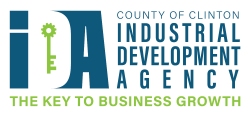General Assistance
Bond Financing: IDAs and CRCs can offer tax-exempt Industrial Revenue Bonds (IRBs) to qualified projects. A good estimate is that tax-exempt financing is between 67-70% of what the comparable rate on a taxable financing would be. Eligible Projects Include: Purchase & Rehabilitation of existing buildings, Constructing of new buildings or additions; and Financing of machinery & equipment in conjunction with construction, rehabilitation or additions to a facility that is Industrial, Warehousing, Research, Tax-Exempt Projects, Small Alternate Energy Projects, Wind Farm, Commercial – Permitted Retail and Permitted Medical, Residential, Distributive Service, Recreation, or Adaptive Reuse
Mortgage Recording and Sales Tax: Both the IDA and CRC can offer exemption from the Mortgage Recording Tax and NYS Sales Tax for Bond Financed and Straight-Leaseback Transactions projects
CRC Assistance
Bond Issuance Fees: The CRC is not subject to the NYS Bond Issuance Charge. Depending on the size of the principal, this effectively eliminates a fee of up to .84%
IDA Assistance
Straight-Leaseback Transactions: IDAs can undertake a transaction in which the IDA takes title, possession or control of a property of a project occupant. This entitles the property to be exempt from taxation, even though no financial assistance in the form of proceeds of bonds issued by the IDA is provided to the project occupant. Depending on the type of transaction, the IDA’s possession can last for one day or the term of the project (10-15 years). The IDA possession does not impinge on the owner’s ability to finance and grow the business. Projects must be manufacturing or industrial in nature or have a public benefit to the community.
Payment-in-lieu-of-Taxes (PILOTs): A project may qualify for a PILOT from the IDA if it meets the eligibility criteria. An agreement is entered into between the IDA and applicant, the applicant agrees to make payments in lieu of taxes for which they would responsible for, if this were not an IDA project.
IDA Tax Abatement Schedule: Following is an example of a typical 10-year Payment in Lieu of Tax agreement (PILOT) schedule. We have three categories of approved PILOTs, as well as a standard PILOT for alternative energy projects.
The CCIDA has a Uniform Tax Exemption Policy (UTEP) in place for conventional projects that has been pre-approved; please see our UTEP policy on the CCIDA website for background. The Agency can deviate from its UTEP for unique projects with the knowledge of all the affected local governments and clear reasons for the adjustment.
| Tax Year Commencing During Fiscal Year | Percentage of Normal Tax |
|---|---|
| 1 | 50% |
| 2 | 55% |
| 3 | 60% |
| 4 | 65% |
| 5 | 70% |
| 6 | 75% |
| 7 | 80% |
| 8 | 85% |
| 9 | 90% |
| 10 | 95% |
| Year 11 and thereafter during the term of the PILOT Agreement | 100% |
Some background on Process and Oversight
PROCESS IDA-CRC
- All IDA-CRC assistance must induce the project. It is important that we are involved in the project early, before decisions are made finalizing the project. Don’t call us if you’re going to announce opening, we can’t help!
- The IDA-CRC application, our Cost Benefit Analysis, Uniform Tax Exemption Policy (UTEP), Environmental (SEQR)form, policies and fee schedule are available on the information page.
- We can consider changes to our policies, but deviations must document the reasons for any change and Board must approve change.
- The CRC differs from IDA in that it is a not-for-profit essentially making a loan to the project. IDAs cannot make loans.
- These are public processes. Once an application is accepted, its published on our website.
- We are subject to Open Meetings Law and Freedom of Information Law (FOIL)
- Public hearings are required for all IDA and CRC projects.
- Timing: this varies depending on type of assistance and complexity of project. From receipt of a complete application
- PILOT could be in place within two to three months.
- CRC financing could close as early as six to seven months, maybe sooner depending on when company needs funds.
OVERSIGHT IDA-CRC
- The IDA and CRC will review all active projects twice a year, through an annual audit letters and outreach contacts.
- We track the use of financing, tax incentives (sales and real property), PILOT payments and company’s success in meeting application economic development benchmarks, e.g. job creation, investment, etc.
- Failure to meet targets contained in application will be reviewed by the Board and possible actions will be considered, including recapture of in-excess tax exemptions, adjusting incentives, claw backs, etc.
- The information we collect is reported to the Comptroller and posted on a public website.

